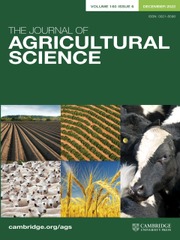No CrossRef data available.
Article contents
Decoding biochemical trait inheritance through generation mean analysis in pearl millet [Pennisetum glaucum (L.) R. Br.]
Published online by Cambridge University Press: 10 September 2025
Abstract
Pearl millet is a vital nutri-cereal that serves as a staple food and a significant source of calories for millions of people in arid and semi-arid tropical regions. The present work aims to conduct various genetic interpretations using six generations of six crosses, which were evaluated during the South-west monsoon season 2021 and 2022 at IARI, New Delhi, India for different biochemical traits. Amylose content (AC) among all the genotypes varied from 21.3–26.4g/100g, starch content (SC) from 56.1–71.0g/100g, oil content from 5.37–13.2g/100g, total protein content from 5.7–14.7g/100g, phytic acid content from 0.86–1.01g/100g and total phenolic content (TPhC) from 0.06–0.19g/100g. Seed yield per spike (SYS) showed positive correlation with thousand seed weight (TSW) and SC while there was negative correlation with protein content. Significant variation was observed for almost all the traits except in a few cases. AC and SC were governed by both additive and dominant gene actions. However, phytic acid, TPhC, TSW and SYS exhibited a stronger bias towards dominant gene action, therefore selection can be delayed to later generations to achieve greater homozygosity and trait stability. In contrast, oil and protein content were primarily controlled by additive effects, indicating that early-generation selection may prove beneficial for identifying superior breeding lines.
Information
- Type
- Crops and Soils Research Paper
- Information
- Copyright
- © The Author(s), 2025. Published by Cambridge University Press


